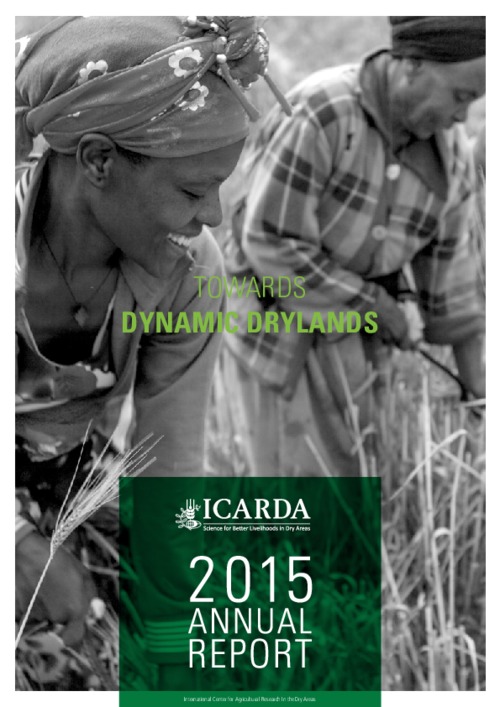Location
The International Center for Agricultural Research in the Dry Areas (ICARDA) was established in 1977. It is one of 15 such centers supported by the CGIAR. ICARDA’s founding mandate to promote agricultural development in the dry areas of developing countries remains highly relevant today.
ICARDA works with a tight focus on the problem-solving needs of resource-poor farmers, achieving this through the in-field delivery of its research outputs. Although global food production has increased by 20 per cent in the past decade, food insecurity and poverty remain widespread, while the natural resource base continues to decline.
International research centers such as ICARDA, which have helped drive previous improvements, continue to deliver new technologies to support sustainable growth in agriculture, and crucially, to work with a wide range of partners to accelerate the dissemination of these technologies.
ICARDA’s biggest strength is its staff – 600 highly skilled men and women from 32 countries. Our research and training activities cover crop improvement, water and land management, integrated crop-livestock-rangeland management, and climate change adaptation.
Other interventions include:
- Water harvesting - supplemental irrigation and water-saving irrigation techniques
- Conservation agriculture methods to reduce production costs and improve sustainability
- Diversification of production systems to high-value crops – horticulture, herbal and medicinal plants
- Integrated crop/rangeland/livestock production systems including non-traditional sources of livestock feed
- Empowerment of rural women – support and training for value-added products.
The ICARDA genebank holds over 135,000 accessions from over 110 countries: traditional varieties, improved germplasm, and a unique set of wild crop relatives. These include wheat, barley, oats and other cereals; food legumes such as faba bean, chickpea, lentil and field pea; forage crops, rangeland plants, and wild relatives of each of these species.
ICARDA’s research portfolio is part of a long-term strategic plan covering 2007 to 2016, focused on improving productivity, incomes and livelihoods among resource-poor households.
The strategy combines continuity with change – addressing current problems while expanding the focus to emerging challenges such as climate change and desertification.
We work closely with national agricultural research systems and government ministries. Over the years the Center has built a network of strong partnerships with national, regional and international institutions, universities, non-governmental organizations and ministries in the developing world and in industrialized countries with advanced research institutes.
THE ‘DRY AREAS’
Research and training activities cover the non-tropical dry areas globally, using West Asia, North Africa, Central Asia and the Caucasus as research platforms to develop, test, and scale-out new innovations and policy options.
Dry areas cover 41 per cent of the world’s land area and are home to one-third of the global population. About 16 per cent of this population lives in chronic poverty, particularly in marginal rainfed areas. The dry areas are challenged by rapid population growth, frequent droughts, high climatic variability, land degradation and desertification, and widespread poverty. The complex of relationships between these challenges has created a "Poverty Trap."
Members:
Resources
Displaying 181 - 185 of 431Livelihood type-specific behaviours regarding household choices in land use and management practices
This report focuses on the analysis of livelihood type-specific behaviors regarding household
choices in land use and management practices. This is a contribution to the overarching
framework of “Integrated Systems Analysis and Modeling in Aral Sea Region” activity within
Dryland System CRP. The report is based on further analysis of baseline data collected within
“Innovation Platform” activity, surveyed and reported in 2015 (Rudenko 2015). Preliminary
analysis of household survey data including description of the study area and the content of
System Dynamics Modelling Approach to Determine Sustainable Stocking Rate for a Sheep Population in the Ethiopian Highlands
A system dynamics approach was used to determine the sustainable stocking rate of the Menz sheep population in the Ethiopian highland. A model was developed to simulate stocking rate based on communal grazing land. The model is weather and resource (feed supply) driven. Pasture growth and dynamics was modeled using rainfall and temperature data. Herd dynamics was based on age groups of male and female animals from birth to herd exit, taking production and reproduction parameters into account.
Putting Economic and Environmental Sustainability Hand in Hand to Protect Our Lands
Land degradation is an underestimated global concern with far-reaching
implications affecting the ability of land to provide food and incomes. Globally, a
large portion of the vulnerable human populations—the rural poor—live on
degrading and less-favored agricultural lands without market access.
Heterogeneous solutions that ensure both economic and environmental
sustainability are needed at multiple scales.
On a policy level, awareness of land and soil degradation is increasing. Last year
ICARDA Annual Report 2015
The year 2015 will be remembered for the waves of refugees from the Middle East and North Africa (MENA) region looking for a safer future in other parts of the world. While millions of people crossed into Europe, the international community looked for the roots causes of the migration, recognizing that food insecurity, unemployment, drought and environmental degradation all play a role in the uprising and coalescing of conflict.
Wheat Landraces Currently Grown in Turkey: Distribution, Diversity, and Use
From 2009 to 2014 a nationwide effort was made to document, collect, conserve, and characterize wheat landraces grown by Turkish farmers. Spike samples were collected from more than 1600 farmers from 59 provinces, planted as single-spike progenies, and classified into species, subspecies, and botanical varieties (or morphotypes). Altogether, 95 morphotypes were identified representing three species and six subspecies: einkorn wheat (Triticum monococcum L.), emmer wheat [T. turgidum subsp. dicoccon (Schrank) Thell.], cone wheat (T. turgidum subsp. turgidum), durum wheat [T. turgidum subsp.







